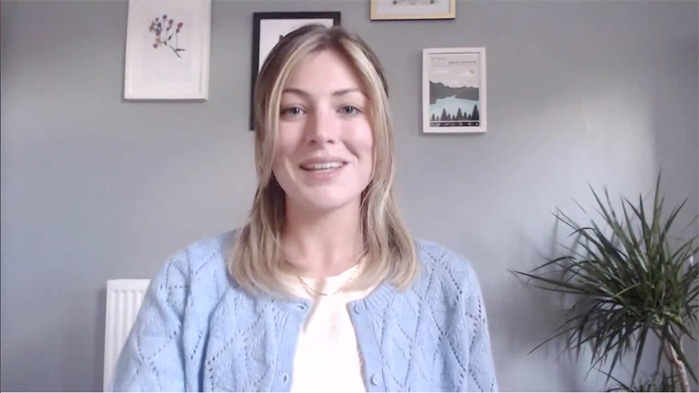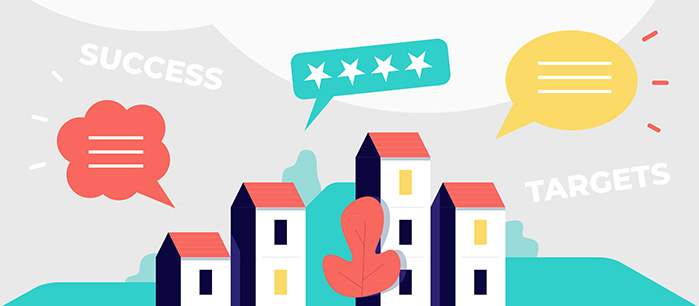Overcome the difficulties of distance, bridge gaps between you and your customers, and transform your results when selling remotely.
Selling is an ongoing series of communicative efforts between two parties. In fact, speaking of parties, let’s imagine sales as a dance. Both participants express themselves, each telling their own story, and responding to the moves of the other, until the two align in beautiful cohesion. You might more frequently hear of selling being likened to sports. We just can’t get behind this analogy. To us, it’s a creative collaboration and, in our scenario, no one loses.
As in dance, pulling off this harmony requires communication beyond words. A crossing of the arms can signal you’ve hit a nerve, the tiniest shift in seating position can let you know your dance partner is uncomfortable, just as a slight relaxation in posture can tell an experienced salesperson they’re making progress.
While Strictly may have managed to pull off social-distanced dancing, in March of this year, many of us found the move to remote selling to be damaging to our relationships, and our lead generation.
What’s the problem with selling remotely?
You’ve been cruelly separated by distance from your dance partners, forced to communicate and choreograph a spectacle over dodgy internet connections and a chorus of “You’re muted. I can’t hear you, Barbara.” These are not optimal collaboration conditions. Google didn’t create a purposefully-frustrating, poorly-kitted-out breakaway room in their California Headquarters, did they? No, they brought people together, face to face, to scale climbing walls and play beach volleyball, to bond and ‘casually collide’ and, ultimately, become more productive.
When it comes to selling, you need to put every piece of client information together, in order to come up with the most enticing proposition for your prospective partner. And when I say all the information, I mean body language, tone of voice, and every minute action – right down to those fleeting breaks in eye contact. You even need to feel how enthusiastically they shake your hand once the meeting is over. You may not realise you’re banking this information, but if you’re any good at your job – heck, if you’re any good at being a human – it will influence every move you make.

Uncertain times
It’s these pieces of non-verbal information that have been taken from us. Remote selling has left many competent salespeople perpetually puzzled. Did they really like that work example you showed, or were they just being polite? Did they plant that crying child in the background as a get-out plan? Was their internet connection really that poor, or did they keep their camera off so you couldn’t see they were making dinner as you gave them your best pitch?
This lack of visibility when it comes to the full client picture is an inconvenience, but not a complete loss. It’s important to acknowledge these issues, so that you can adjust your approach and behaviour to replace what’s missing. If you work in sales, it’s your job to work smarter to find this information elsewhere and paint the full picture with different materials.
To put it simply, you’ve just got to up your game.
Be more you when selling remotely
Put some pep in your step
People buy from people they trust, but this trust is harder to build when miles separate you. Your personable approach can become diluted across Zoom (other video conferencing software is available, apparently…try telling that to Skype), so make sure to amp it up. Give yourself a pep talk before each remote sales call, do some jumping jacks, remind yourself why you love your work. Basically, hype yourself up so that your energy, your emotion, your passion is through the roof when you communicate. Grab their attention when so many other things are trying to pull it away.
Make yourself at home
Consider changing your approach entirely and dropping your usual formalities. After all, you’re usually a guest in their place of work and you show that you respect their invitation in your manner, your tone and your best blazer. But now, they’re a guest in your home, and you in theirs. Try getting a bit familiar when you’re selling remotely. Don’t hide your favourite paintings or personality pieces from view, show them who you really are. Break down those professional barriers and create deeper bonds, quicker. Be a friend in a time when we all need a little more comfort. You should be able to judge each situation individually as to how comfortable you’re prepared to get. Just remember, tops are never optional.

Say what you feel
If you’re connecting through voice only when selling remotely, both you and your dance partner have even less data to go off, so make sure you account for this loss in your actions. Instead of silently thinking about the point they just made, say “hmm…” so they know you’re thinking, and they still have your attention. Laugh when you’d naturally smile. Verbalise your absent actions.
Be more nurturing when selling remotely
Make an effort
We all need to make more of an effort to connect. With so much going on in the world, so many new processes and routines to adapt to, now is the perfect time to overcommunicate.
Pick up the phone more than you usually would to stay at the forefront of a prospect’s mind, send them blog articles you think might be valuable to them, ask if there’s any way you can make the decision easier for them or another stakeholder. Go above and beyond to connect and communicate while we’re unable to be physically present.
Nurture collaboration
This goes for internal sales teams as well. Make sure you’re checking in with the rest of your team daily, if just to see how they are. Have regular pipeline reviews to identify potential barriers before they happen. Share ideas, client stories, remote selling successes, failures, and happy bear gifs. Nurture collaboration internally to see the benefits spread externally.
Be more accessible when selling remotely
Make yourself multi-channel
There are so many platforms and technologies designed to make communication, and remote sales, easier, that choosing the right one becomes the biggest problem. Our advice: get to know them all, then let your client take the lead on the one that best suits them.
Video calls
However, always push for video conferencing where possible. It’s the closest thing to face-to-face, at least until VR meetings or holographic projections become household options.
Video conferencing allows you to still build rapport, react in real time, and take in some body language and facial expressions, even if they might come with a slight delay. In fact, 82% of people surveyed said they felt greater trust when using video in meetings, and 91% said there was greater engagement, leading to better understanding through non-verbal communication.
Video attachments
Voice calls seem like the logical next in line for the remote sales throne, and for many clients and situations they will be, but don’t underestimate the power of recording a personal video and sending it in an email. Video allows you to be personable, give the illusion of eye contact, communicate through body language, and it’s permanent, so your prospect can watch it in their own time, and share it with other stakeholders, doing some of the remote sales legwork for you.
Whatsapp and text
Whatsapp and text are immediately counted out by the old boys of business, but those guys are quickly getting left behind by this fast-moving business landscape, so don’t take remote selling advice from them. People associate these forms of communication with friends and family, and you can use that to your advantage to connect on a deeper level. Plus, most people find it impossible to ignore an incoming text or Whatsapp notification, which is perfect for grabbing the attention of a particularly slippy customer. Instead of only sending text through these platforms, integrate other media to communicate on multiple layers, and reduce the risk of your message being misinterpreted.
Social media
And, of course, don’t neglect social media. Being active on social media has been an asset in the arsenal of salespeople for a long time now, but don’t stop posting just because you have other challenges to face. Remaining relevant on social will create much-needed new connections and keep you front and centre of customer’s minds. In a time when physical networking is impossible, concentrate on social networking instead.

Emails are a big part of business communication, but they shouldn’t be your go-to. Always think about how you could be interpreted, whether there’s a chance to personalise your interaction, and how to add more personality to your remote sales communications. When we speak to someone face to face, we can draw on their emotions and get them excited about working with us. As soon as we revert to text-only communications, we let the logical part of their brain take over, and people don’t make decisions based on logic. It’s more likely they’ll talk themselves out of saying yes to that next dance.
Instant booking
Once you’ve charmed customers through whichever media platform suits their work style, don’t forget to make it easy for them to get in touch with you as well. Adding meeting booking links to your communications removes barriers and lengthy email exchanges, making potential clients more likely to commit to that all-important pitch.
Be more consistent when selling remotely
Mister Motivator
Lack of motivation is a problem affecting a lot of remote workers, not only salespeople. It’s the burden that doesn’t discriminate. When in the comfort of your own home, there are distractions pulling you in every direction and the temptation to sack off your work and stay in bed is the perpetual devil on your shoulder. Add the frustration of a budget-conscious business landscape and throwing in the sales towel might look really good right about now.
The antidote to this issue is in building habits. We just need to adapt and find a new routine and you’ll find yourself back in business mode in no time. Try to find a trigger that starts and ends your working day. It could be as simple as going for a walk, as if you were still commuting. Pick a daily habit that tells your brain “this is the start of my working day, it’s all business from here on out.” And make sure you have another trigger to signify clocking-off time, giving yourself that all-important worklife balance.
Beyond these signals, try to set aside blocks of time for different activities, and set yourself daily goals. You might challenge yourself to reach out to three potential new leads between 2 and 3pm or put 10 to 11am aside for generating new ideas for social posts. Whatever your remote selling goals are, plan your time out to avoid twiddling your thumbs and wasting time deciding what to do next.
Rise and shine
Anything that could directly lead to a remote sale is best tackled in the morning. After a refreshing night’s sleep, both you and your prospect will be more energetic and likely to engage. Consider making these calls, and setting these video meetings, for around 10am to give yourself the best chance of choreographing a masterpiece.
Little touches
In the same way you should plan out your day from start to finish, you should look at the customer’s journey from end to end. How could you automate certain interactions, in order to free up your time and create a consistent remote selling experience? If you use CRM software, like HubSpot, you can set tasks to be created automatically as a customer moves through the journey.
These consistent interactions can be just the nudge a potential partner needs to commit to waltzing with you. It’s important you take the time to adjust the sequence to fit the work style of the customer. If you’re sending the same email out to everybody at the same time, with no personal touches at all, you may as well not bother. Take advantage of automation to enhance your interactions, not replace them.
Be more Sherlock when selling remotely
To make up for the missing body language data, we can look to analytics to provide the same information. Use tracking tools when you send emails to give your remote selling comms a fighting chance in a competitive inbox environment.
Did they open your email more than once, or not at all? Did they click the link through to view the content? Did they forward it to another stakeholder?
Understanding this information will make your next move obvious. If your initial email wasn’t opened, you might be wasting your time sending a follow up. If it was opened multiple times, it might be time for a call, as they’re obviously interested. Did they ignore the link you sent, but navigate through to your Instagram to look at examples of work? Perhaps send your showreel, while you have their attention.
This kind of tracking may seem creepy and invasive when it’s not something you’re used to, but is it really any creepier than studying the corners of someone’s mouth for a hint of a smile or the dilution of their pupils for a slight glimpse of delight? The future is now, baby. When you’re selling flying cars to robots, you’ll be glad you got the practice in early.
If you use these tips throughout your dance of seduction, and you’re sure to win that big pitch.
But then what?
Before the remote sales meeting
Put your cards on the table
We’re all bloody confused right now. If you think you might not have given your new dance partner enough information, you’re probably right. As soon as the meeting has been booked, let them know what to expect. Send out an agenda for the client to sign off, tell them what you need from them and give them the opportunity to return the favour. And cover off meeting etiquette: cameras on, distractions off. By putting in this extra effort at the start, you’ll avoid the unnecessary stumbling and fumbling that can easily eat into the first ten minutes of your call.
A quick reminder
Consider sending out a friendly reminder ahead of the meeting as well. Back in the day, if you showed up to their office at the agreed time, even if they’d completely forgotten you were coming, they would pretty much have no choice but to talk to you. However, a remote sales meeting is a lot easier to bail on. Minimise the risk of being stood up by asking for a quick confirmation that they’re still available.
Control and competence
Enough about them, let’s talk about you. Don’t get so focused on prepping your client for this new world of fuzzy cameras and muffled mics that you forget to get yourself ready. You may have presented these materials a million times, but remote selling changes everything.
Firstly, you’re no longer just a salesperson, you’re now IT. You need to know the technology you choose to use inside-out. Remember, this is completely new for many people. We’ve all had meetings where the first twenty minutes are spent trying to figure out why Jeff can’t hear what you’re saying. Demonstrate control and competence at every interaction, and across every issue, and this will positively impact their opinion of your credibility when it comes to your products and services.
Dress (your space) for success
For this next point, I’d like to invite you to cast your mind back to simpler, pre-COVID times. Picture the anticipation of that first meeting with a potential new client. Remember how much care and attention you would pay to how you dressed? How you did your hair? How you presented yourself? Well, the workload is certainly reduced now that they can’t see anything from the chest down, right? Wrong. You need to take this attention to detail and redistribute it to your virtual set up.

Hi-tech home office
It’s likely we’re going to be working remotely for a long time, in fact, we’ll probably never return to exactly how things were. Investing in your at-home technology will pay off in the long run.
Think about the quality of your video. Integrated webcams are notoriously crap, and you can buy decent external ones for very little money. Remember, we’re trying our best to claw back those missing pieces of information from when we could meet in person. Having a poor-quality video output will add an unnecessary barrier between you and your customer.
A high-quality microphone could also be a good idea. Uni-directional microphones will help you cut down background noise and keep the attention on you.
And finally, consider your lighting. We’ve all been on a remote sales call with someone who’s positioned themselves with their back to an open window, making it look as though their identity has been hidden for their own safety. Don’t be that guy.
If you have good natural light, try setting up your desk so you’re facing towards it. If this isn’t possible for you, you can buy LED lights for fairly little cost. Think about getting two so you can place one on either side of you, to eliminate shadow.
If you’re not sure what you need, ask a colleague to jump into a video meeting with you. They can talk you through the experience from the client’s point of view.
Change your story
If I see the word ‘unprecedented’ one more time, I swear I’m going to cut myself off from society for good, but it is true that your clients are currently facing challenges that they haven’t faced before, and your pitch messaging needs to reflect this.
Your solution might be the same whether there’s a global pandemic or not, but your story needs to acknowledge your clients’ struggles. Show you understand, and provide a clear solution. It needs to be relevant to their lives right now.
Optimise your materials for remote selling
Integrating multimedia into your presentation materials is great for keeping your audience engaged when selling remotely. However, you need to be aware of the effect media can have on your file size, and your final presentation. Large files are more likely to result in lagging animations and videos that refuse to load. Add in potential delays from remote screen sharing, and your audience might end up a few slides behind you.
Think about the type of media you want to add. Could you swap a video for a gif? Or could you get the same impact from simple animated vectors? And always compress your media and test your presentation on a colleague to make sure it runs smoothly.
You can never predict how a conversation is going to go, but life is now more unpredictable than ever. Having a flexible menu system could be a meeting-saver. Let your audience take control and dictate the information they want to hear. And you can still have the security of knowing there’s a slide to support you, just a click away.
Our pitch deck designers are experts in pitching in any environment. They can ensure your messages are heard, even with a dodgy connection.
Pitch time

Dazzle with your delivery
Remember that self-directed energy boost we encouraged earlier? Well, when it comes to presenting your pitch deck during that crucial remote sales call, we need you to amp it up even further. Don’t let video conferencing dilute the passion that is so obvious to the people who have the pleasure of being in the same room as you.
Consider standing up to present, just as you would before all this nonsense occurred. This may feel unnatural at first, but it will allow you to move around more freely. Both your voice and body language will be clearer, too.
Audience interaction
Just because you’re standing alone in your bedroom, don’t be tempted to turn this pitch into a one-person show. Ask more questions at regular intervals, integrate polls or opportunities for your audience to ask questions, and include interactive elements wherever possible. Don’t let distance lead to disconnect, and don’t lose their attention to the pile of washing in the corner.
End your remote sales meeting on a high note
Make sure to end the remote sales meeting as clearly as you began. Outline what happens next in your process, what they can expect from you, and when. Make sure to also cover what you need from them, and set a time for your next catch up. This should keep things ticking along nicely.
Following up your remote sales meeting
Reinventing the humble brochure
Leave-behinds aren’t new to anyone working in sales. However, your choice of media might have to be adjusted for the current climate. If you’re continuing your practice of sending out physical brochures after a meeting, you may as well write ‘danger’ all over an empty Jiffy bag and be done with it. Are we even allowed to lick envelopes anymore?
Here are some ideas for safer, digital leave-behinds:
Summary video
Cut down your slides to focus only on the key points. Add more copy to the slides, so that your presentation makes sense without you there to present it. Set your slides to transition automatically, and simply export as a video. You can even add audio narration, if you’re feeling fancy.
Interactive PDF
PDFs are smaller in file size, making them easier to email, but you will lose all your beautiful animations. However, you can add links to further information, or other points in the document, and embed videos to replace that missing motion.
HTML email
You could create a beautiful and slick follow-up email in the same design as the presentation they’ve just seen. Again, make sure you cut the information down to just the key points, bringing in links and other media to build out the message.
Whichever leave-behind method you choose, make sure it’s beautifully designed and clearly laid out. The messaging needs to be brief enough to keep their interest, but extensive enough to work without you present. If that all sounds like hard work, get in touch with our remote sales team to find out how we can do it for you.
Is remote selling here for the long haul?
We know you extroverted salespeople are desperate to get back in the field. But we’ve got to acknowledge the benefits of remote selling. In many ways, it’s a much more efficient and cost-effective way to operate. We wouldn’t be surprised if organisations adopted a hybrid approach once this damn pandemic is nothing more than a distant memory.
Less travel reduces costs, complexities and eliminates wasted time standing on underground platforms, getting lost in unknown lands, or losing signal on a train in the middle of nowhere. This means you can be more strategic with your time. Fit in more meetings or make the most of focus time to come up with creative ways to connect. Show your customers you recognise the value of their time, by condensing meetings down to just half an hour. As no one has to offer complimentary coffees or spend fifteen minutes trying to find an available meeting room, you can just get straight down to business, which is great for business.


